Live imaging of neutrophil motility in a zebrafish model of WHIM syndrome
- PMID: 20592249
- PMCID: PMC2974588
- DOI: 10.1182/blood-2010-03-276972
Live imaging of neutrophil motility in a zebrafish model of WHIM syndrome
Abstract
CXCR4 is a G protein-coupled chemokine receptor that has been implicated in the pathogenesis of primary immunodeficiency disorders and cancer. Autosomal dominant gain-of-function truncations of CXCR4 are associated with warts, hypo-gammaglobulinemia, infections, and myelokathexis (WHIM) syndrome, a primary immunodeficiency disorder characterized by neutropenia and recurrent infections. Recent progress has implicated CXCR4-SDF1 (stromal cell-derived factor 1) signaling in regulating neutrophil homeostasis, but the precise role of CXCR4-SDF1 interactions in regulating neutrophil motility in vivo is not known. Here, we use the optical transparency of zebrafish to visualize neutrophil trafficking in vivo in a zebrafish model of WHIM syndrome. We demonstrate that expression of WHIM mutations in zebrafish neutrophils induces neutrophil retention in hematopoietic tissue, impairing neutrophil motility and wound recruitment. The neutrophil retention signal induced by WHIM truncation mutations is SDF1 dependent, because depletion of SDF1 with the use of morpholino oligonucleotides restores neutrophil chemotaxis to wounds. Moreover, localized activation of a genetically encoded, photoactivatable Rac guanosine triphosphatase is sufficient to direct migration of neutrophils that express the WHIM mutation. The findings suggest that this transgenic zebrafish model of WHIM syndrome may provide a valuable tool to screen for agents that modify CXCR4-SDF1 retention signals.
Figures

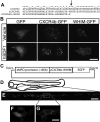

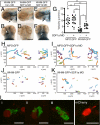
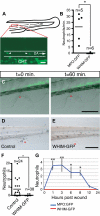
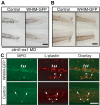
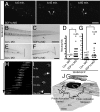
Comment in
-
A WHIM-sical zebrafish.Blood. 2010 Oct 14;116(15):2621-2. doi: 10.1182/blood-2010-07-296426. Blood. 2010. PMID: 20947686 Free PMC article.
Similar articles
-
WHIM syndrome myelokathexis reproduced in the NOD/SCID mouse xenotransplant model engrafted with healthy human stem cells transduced with C-terminus-truncated CXCR4.Blood. 2007 Jan 1;109(1):78-84. doi: 10.1182/blood-2006-05-025296. Epub 2006 Aug 31. Blood. 2007. PMID: 16946301 Free PMC article.
-
CXCR4 dimerization and beta-arrestin-mediated signaling account for the enhanced chemotaxis to CXCL12 in WHIM syndrome.Blood. 2008 Jul 1;112(1):34-44. doi: 10.1182/blood-2007-07-102103. Epub 2008 Apr 24. Blood. 2008. PMID: 18436740
-
Clinicopathologic Features and the Spectrum of Myelokathexis in Warts, Hypogammaglobulinemia, Infections, Myelokathexis Syndrome.Lab Invest. 2025 Aug;105(8):104174. doi: 10.1016/j.labinv.2025.104174. Epub 2025 Apr 14. Lab Invest. 2025. PMID: 40239948
-
Clinical and genetic features of Warts, Hypogammaglobulinemia, Infections and Myelokathexis (WHIM) syndrome.Curr Mol Med. 2011 Jun;11(4):317-25. doi: 10.2174/156652411795677963. Curr Mol Med. 2011. PMID: 21506920 Review.
-
CXCL12/CXCR4-axis dysfunctions: Markers of the rare immunodeficiency disorder WHIM syndrome.Dis Markers. 2010;29(3-4):189-98. doi: 10.3233/DMA-2010-0736. Dis Markers. 2010. PMID: 21178277 Free PMC article. Review.
Cited by
-
Rare Genetic Blood Disease Modeling in Zebrafish.Front Genet. 2018 Aug 31;9:348. doi: 10.3389/fgene.2018.00348. eCollection 2018. Front Genet. 2018. PMID: 30233640 Free PMC article. Review.
-
Plasma obtained following murine hindlimb ischemic conditioning protects against oxidative stress in zebrafish models through activation of nrf2a and downregulation of duox.PLoS One. 2021 Nov 24;16(11):e0260442. doi: 10.1371/journal.pone.0260442. eCollection 2021. PLoS One. 2021. PMID: 34818339 Free PMC article.
-
Neutrophil-Associated Responses to Vibrio cholerae Infection in a Natural Host Model.Infect Immun. 2022 Mar 17;90(3):e0046621. doi: 10.1128/iai.00466-21. Epub 2022 Jan 24. Infect Immun. 2022. PMID: 35072520 Free PMC article.
-
Algal photoreceptors: in vivo functions and potential applications.Planta. 2014 Jan;239(1):1-26. doi: 10.1007/s00425-013-1962-5. Epub 2013 Oct 1. Planta. 2014. PMID: 24081482 Review.
-
Congenital defects in neutrophil dynamics.J Immunol Res. 2014;2014:303782. doi: 10.1155/2014/303782. Epub 2014 Aug 5. J Immunol Res. 2014. PMID: 25165726 Free PMC article. Review.
References
-
- Doitsidou M, Reichman-Fried M, Stebler J, et al. Guidance of primordial germ cell migration by the chemokine SDF-1. Cell. 2002;111(5):647–659. - PubMed
-
- Alkhatib G, Berger EA. HIV coreceptors: from discovery and designation to new paradigms and promise. Eur J Med Res. 2007;12(9):375–384. - PubMed
-
- Gelmini S, Mangoni M, Serio M, Romagnani P, Lazzeri E. The critical role of SDF-1/CXCR4 axis in cancer and cancer stem cells metastasis. J Endocrinol Invest. 2008;31(9):809–819. - PubMed
Publication types
MeSH terms
Substances
Grants and funding
LinkOut - more resources
Full Text Sources
Other Literature Sources
Molecular Biology Databases
Research Materials
Miscellaneous

